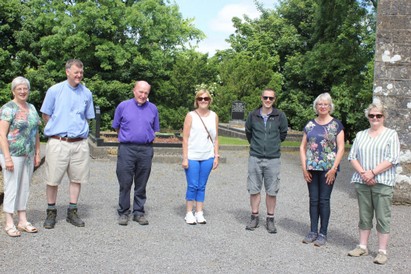21 in 21 ~ Walks 11 - 23
About 25
ladies, gentlemen, children and two dogs assembled outside St Patrick’s Church
in the middle of Monaghan town on a very windy morning to join in a short act
of worship led by the rector of Clones, Rev Roy Taylor, before the beginning of
June’s 23rd walk – the third and final one in the diocese of Clogher.
At the
beginning of this walk, June was accompanied by 18 others - the Diocesan
President, Irene Boyd; the Diocesan Chaplain, Revd. Charlie Eames, Barbara
Clarke, All Ireland PRO for the northern dioceses - the official photographer
for the day; members from several branches and their daughters - as well as the
two dogs. The 7.5km walk was led by the Branch Leader from Clones Mothers’
Union, Linda Keating.
The walkers
headed down the hill from the church, beside the main town car park and across
New Road, to join the designated trail along the disused Old Ulster Canal. This greenway totals 4.2km in length and uses
the towpath of the abandoned canal. Heritage structures along the full route
include three bridges, a lock house and two locks, although the walkers did not
see all these features as, after approximately 2.5 kms, they turned left from
the greenway towards and then through the main gates into Rossmore Forest Park.
Once in those
grounds the remaining walkers (now around 13 in number and one dog) made their
way up the main roadway towards the site of the former Rossmore Castle,
admiring the views over Castle Lake towards “Roddy” one of the stone giant
sculptures which have in recent years been added to the grounds as an
attraction for children. The Park dates back to the 1760s and the castle (the
former home of the Westenras - the Barons of Rossmore) became derelict in the
1950s. The park is now run by the Irish States forestry organisation, Coillte.
As the walkers
had completed more than half the allocated distance, they regretfully turned
and retraced their steps back through the Park (passing another giant –“Banba”-
at the gate) and along the canal pathway back to Monaghan town and up the hill
to St Patrick’s Church where the ladies of the MU branch had kindly prepared
some refreshments. June said she was very tempted to return to Rossmore Park in
the afternoon as it had so much to offer - including a variety of well-marked
walking trails - but perhaps her feet had had enough exercise already that
day!
Before June’s 22nd walk – and the second in TKA - 12 members
from branches near and far met at St Michael’s parish church in Ballina for
morning prayer which incorporated MU Midday Prayers and a short devotion on the
theme of the fellowship of Mothers’ Union. The service was led by the rector,
Archdeacon Stephen McWhirter, assisted by Caroline Morrow, the OLM who is
attached to the parish.
Those who were going to undertake the walk travelled about a
mile across the town to Belleek Forest Park, 200 acres of woodland and trees
which lie on the outskirts of Ballina. These lie in the grounds of the former
home of the aristocratic Knox-Gore family, which was called Belleek Manor and
is now the Belleek Castle Hotel. Nine folk began the walk - led by DP Myrtle
Nairn and her husband David; besides June, the others were Diocesan Trustee
Audrey Moore and her husband Henry, Valerie Wilson (Branch Leader in St
Michael’s), Mildred Gilmore (former DP), and MU members Catherine and Violet.
They walked up a path beside the playing fields and followed
it to the edge of the forest and then joined the marked trail through Belleek
Woods. At this point Mildred and Valerie left the group of walkers. They
continued along the route known as Main Avenue, with the River Moy to their
right and admired the views across the river. Ballina is known as the salmon
capital of Ireland and the river is obviously the hub of its reputation – there
were certainly many boats moored along it.
One particular item of note was the old concrete hull of the
former tug boat, the SS Crete Boom, which has lain derelict on a sandbank
between Ballina Quay and Belleek Woods since 1974. After stopping to discuss
this unusual sight, the seven walkers followed the trail through the woods
admiring the variety of trees; they passed the lime kiln and the main picnic
area, continued along Pine Avenue and up a hill towards the Ring Fort. They turned
and retraced their steps before turning right up another incline and then up
some steps into the grounds of Belleek Castle, where they stopped for a light
lunch in the courtyard.
After the welcome refreshments, the seven walkers made
their way down the main avenue to re-join the trail through Belleek Woods and
on to the path around the recreation grounds, out on to the main access road,
through the entrance arch to the estate and turned left past the Connacht
Distillery to arrive back at car park. They had completed 7.3kms.
June said it had been an interesting walk with some
particularly scenic parts especially along the River Moy, and the history of
the area and the Knox Gore family was fascinating. The rain had even stayed off
until the final 20 minutes which was an added bonus!
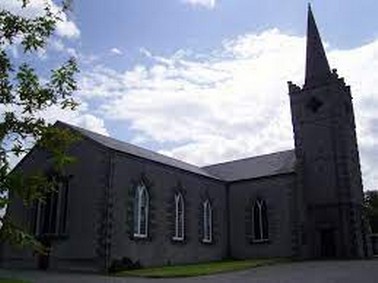
St Michael’s Parish Church in Ballina
June’s 21st walk was the first of the three in Tuam, Killala and Achonry and took place in Westport, Co Mayo, the furthest west June had travelled on this journey. Canon Jen McWhirter, who is also the MU Diocesan Chaplain, led the four other walkers in morning prayer at her parish in Holy Trinity Church in Westport before they set off on their morning’s walk. June hadn’t visited the church before and was amazed at its size and the elaborate Italianate-style marble interior.
The walkers accompanying June were Myrtle Nairn, the Diocesan President and her husband David, and Canon Jen and her daughter. They walked along the road beside Westport College of Further Education, into the grounds of Westport House, passing in front of the Hotel Westport. This was not the usual pedestrian entrance to the parklands but had been opened for a time because the main entrance was closed due to the ongoing and significant restoration work to Westport House. Their path followed the wall of the former walled garden and they turned left to walk along the banks of the Carrowbeg River which flows into Westport Lake in front of the House, currently shrouded in scaffolding and an immense amount of plastic sheeting!
Passing some of the attractions of the Pirate Adventure Park (the commercial enterprise which brings funds to Westport House Park), they turned right to follow the path to an access road around the Park; they also encountered a very imposing statue of Grace O’Malley, the infamous “pirate queen of Ireland”. After a distance they left the road to take a path to the left which led them around the side of the Lake. Eventually the walkers re-joined the main road through the estate, crossed over a bridge where a tributary flows out into the estuary which becomes Westport Harbour, and left the Westport House estate.
The group walked along Cinnamon Quay, passing the old Customs House, as well as blocks of apartments constructed in the style of the former warehouses which stood on those sites.They continued along the length of the harbour admiring the views across Clew Bay to Croagh Patrick and Clare Island and continued out to Westport Point, passing the Clew Bay Heritage Centre. It was such a glorious morning, they were tempted to take a cruise out to the 365 islands in the Bay, but decided to leave that until another day!
The distance covered in just under the first hour was 3.5kms so they turned and did it all in reverse, taking a slightly different route through Westport House Park passing beside the entrance to the main visitor centre and the caravan and camping areas. June felt it had been one of her most varied walks – open parkland, a stately home (even though it was disguised!), woods, lake, river and sea with Croagh Patrick hovering in the background - on a morning with perfect weather, light cloud, some sunshine and a slight breeze.
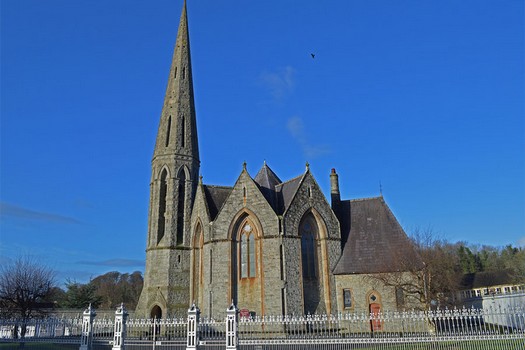
Holy Trinity Church ~ Westport
On this final walk in KEA, Walk Number 20, at Strandhill, June realised precisely why the town has that name, as she walked on the strand, and under the hill which overlooks the town – and encountered too quite a steep incline back uphill at the end of the walk.
To begin the day there was a lovely service in St Anne’s Church on the outskirts of Strandhill - it was led by the Rev’ds Michael and Ann Wooderson and was based on the prayers for Mary Sumner Day which had been the previous day - 9 August. The service had been prepared by the rector of St Anne’s, Dean Arfon Williams, who was unable to be present due to another commitment but sent his best wishes for the day. June also gave a short welcome and explained about the purposes of the “21 in 21” walks.
There were 23 people at the service – a wonderful turnout of members who came from many parts of the diocese. The branches represented were Boyle, St John’s and Calry, Drumcliffe, Drung, Killeshandra, Longford and Swanlinbar. Immediately after the service18 ladies set off down the hill from the church towards the town of Strandhill. Those present included Diocesan President Hazel Speares, Diocesan Secretary Barbara Smith and Trustees Dolores, Evelyn and Mary. The walk was led by Marlet Hunter, the local branch secretary who is also a diocesan trustee. They were overshadowed at that point by the wonderful Knocknaree Hill which dominates the entire area.
They walked down a path towards Sligo Bay and turned left with the shore on their right side - with the tide at that time far out - on the path to the entrance of the area known as Killaspugbrone. They followed the stone path and then the recognised trail along the coast, through the forest and to the shore beyond. On the open parts of the path they had the wonderful vistas across Sligo Bay towards Rosses Point and Coney Island and beyond – the views were marvellous on such a clear morning.
The walkers chatted and caught up with old friends and MU news as they passed along the trail covering a variety of terrain with many types of unusual wild flowers. Then they walked along the sand at Nun’s Bay towards the ruins on a small island and learned from the local ladies the stories about the visit of St Patrick to the area (how he fell crossing the sands and broke a tooth!). They also heard about the convent which had been based on the island for many centuries.
Coming towards Strandhill town, they watched the surfers close to the shore and then walked along the boundary of the small airport and through a caravan park to rejoin the main road and walk up the steady incline back to St Anne’s Church. There they had a very welcome cuppa and marvelled that the weather had been so kind after many days of rain. It had been a really great walk combining long overdue fellowship and wonderful scenery!
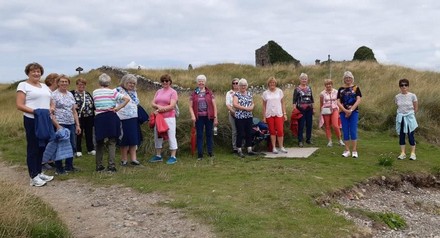
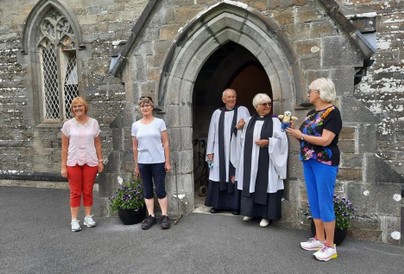
June’s 19th walk on 7th August was the wettest walk to date - and now it is over she hopes it will be the wettest of the 36 walks! It was the first of the three scheduled in Dublin and Glendalough Diocese beginning from St Brigid’s Church in the centre of Castleknock in north-west Dublin. Eleven members and friends joined in prayer in the church at 11am - those who were going to walk and some others including Anne Cadoo (Branch Leader) and MU stalwarts Jean Denner and Pat Gray. The lovely prayers were led by the rector of Castleknock - Canon Paul Houston. June had time inside to admire the beautiful church and especially the fabulous Harry Clarke window, depicting the saints George, Hubert and Luke.
Philip Good took some photographs before the group of six walkers - Diocesan President Karen Nelson, Trustee Olive Good, who led the walk, Erin, Anne, Canon Paul and June - donned their wet weather gear, grabbed a few umbrellas and headed out from the church grounds on to Castleknock Rd. It was not a morning for dallying and they headed towards the Castleknock Gate of Phoenix Park at a brisk pace. There was a lot of chat as they walked – mostly in pairs - and June who walked with Canon Paul found out a great deal about the parish of Castleknock and about Phoenix Park - and its residents.
Phoenix Park is one of the largest enclosed public parks in any capital city in Europe. It was originally formed as a royal hunting Park in the 1660s and opened to the public in 1747. A large herd of fallow deer still remain to this day. The Park is also home to the Zoological Gardens, Áras an Uachtaráin, and Victorian flower gardens, of which they caught a glimpse - but they didn’t encounter any deer. The park is a great resource for both locals and visitors with many sports facilities well as walking and cycling paths.
Once in the Park, the group strode down the path beside the main thoroughfare, Chesterfield Avenue, followed it to Aras an Uachtaráin where they turned left towards the Park’s Visitor Centre and took respite from the downpour under an arch at the Phoenix Café with a welcome hot drink. To that point the walkers had covered just over 4kms. The rain was easing slightly and they then set off on the return leg on a path to join the North Road, followed it to Mountjoy Cross, one of the main thoroughfares within the Park where they turned right again on to Chesterfield Avenue. At this point the rain had eased somewhat and they were better able to appreciate the landscape of the Park and particularly the wonderful, majestic trees, many of which have been there for centuries.
They followed the path beside the road back to Castleknock Gate and retraced their steps back to St Brigid’s Church. The walkers had covered a distance of over 7.2kms in a relatively short time but were glad at the end of the walk to get out of the rain. Ironically, a short time later, the rain ceased completely and it was a lovely - dry - afternoon!
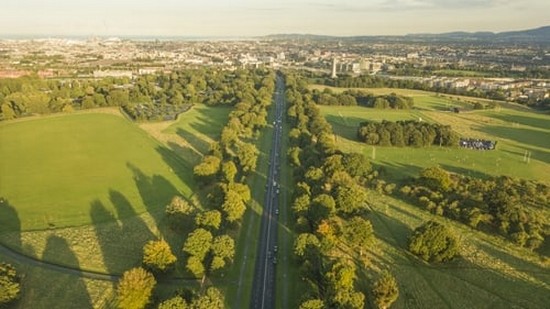
The Phoenix Park
About 15 folk from MU branches across the Diocese of Cork, Cloyne and Ross met at the parish church of St Mary at Doneraile in north Cork to be greeted by the MU branch leader, Ruth Sherlock, and members of the branch. Others present included DP, Hilary Dring, and Trustees Hazel Sherlock and Avril Jennings. Before June began her 18th walk, there was a short poignant service led by the new rector of the Mallow Union of parishes, the Rev’d Meurig Williams, who gave a short reflection on Mary when she is first mentioned in St Luke’s gospel, and led the worshippers in relevant prayers.
The members then broke into two groups – those who undertook a shorter walk in Doneraile Pk and seven ladies - June, Hilary, Avril, Anne, Jean and Linda who under the leadership of Hazel - walked from the church up the hill along the main road to cross it and enter the park by its former main gate. They tackled the path around the perimeter of the park which was no mean feat on such a hot airless day – June commented that the thermostat in her car had reached 30 degrees as she had driven there! However parts of the path were shaded by trees which brought welcome relief from the sun.
Sir William St Leger built the original St Mary’s Church in 1633 on a site across the road from his home, Doneraile Castle. In 1726 the church was rebuilt by the first Viscount Doneraile and, around the same time, he built Doneraile Court, a magnificent Georgian mansion house. It still sits in grandeur at the edge of 400 acres of landscaped parkland and it was the whole way round these grounds that the group walked. The Court and the Park are now maintained by the Dept of Public Works and are a wonderful amenity for those who live in the area.
The path they followed was undulating in parts but the views over the park and surrounding areas were beautiful. The old deciduous trees were tall and magnificent, the wildflowers blossoming everywhere, the smell of wild garlic wafting in the air and young deer grazing without a care; they were curious about these passers-by and sometimes came close to the fences but the parents tended to stay further away. Towards the end of the designated path, the group veered to the left to enable them to go across the front of Doneraile Court, past the courtyard and up the pedestrian path to the village of Doneraile. They then walked down the main street, admiring the wonderful Georgian architecture of many of the houses, over the bridge crossing the River Awbeg and up the hill to return to St Mary’s church. There they were welcomed again by Ruth, Ina, Vivienne and the MU team and were served a wonderful afternoon tea – MU hospitality once again to the fore!
June was presented with a book about Doneraile Park by the Branch and Hilary also gave her a bag of “goodies” – food items all originating from Co Cork with which to remember her walks in the Diocese. In thanking them, June said that it had been an important day for her - it marked the half way point in her series of 36 walks and theirs was the first Diocese in which she had completed all three walks – the full 21kms!
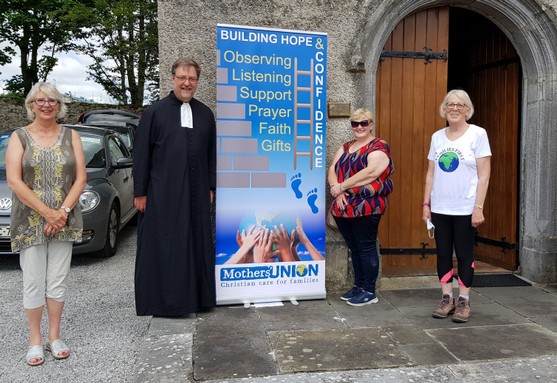
June’s 17th walk – and second in Cork, Cloyne and Ross - began at the Parish Church of St Peter where Rev Robert Ferris (the incumbent in charge of three churches in the Carrigrohane Union) led a short period of worship with 12 MU members present. The service was streamed and recorded to be available to members who were unable to attend. At the beginning June spoke briefly about the “21 in 21” walks, the reason she had undertaken this walking challenge and about MU members across Ireland working to raise money to support this MIM Fund from which grants ultimately came back to all the dioceses to support projects enabling members to help those in their communities.
It was another glorious day and everyone felt that God was blessing these 7km walks in Cork, Cloyne and Ross. Four others joined June on this walk – DP, Hilary Dring, who led the walk – Patsy Devoy (All Ireland VP), Pam Wood and Deirdre Whitley (Diocesan Trustee). The ladies walked up the hill beside the straight N22 road towards Cork city and turned left after about 2kms to follow a path towards the River Lee in an area where a “greenway” to planned to stretch from Ballincollig into the City. They walked with the river to their left – passing on the other side of the river developments which will eventually turn the former huge Our Lady’s Hospital into apartments – it is apparently the longest building in Ireland. They followed the riverside path, turned left across a small bridge, walked for a time with the River Lee to their right and turned right to cross over the “Shakey” (or Daly’s) Bridge which has been recently restored and reopened for public use. It is the only surviving suspension bridge of its type in Ireland.
The group walked with the River Lee again to their left and through Fitzgerald Park. Crossing in front of the Cork Public Museum, surrounded by fabulous rose gardens, they then proceeded up the steps to the main campus of University College Cork, which was founded in 1845 and walked thought the archway to marvel at the spectacular quad surrounded by 19th century buildings – the most peaceful place they had been all morning. They followed the path past the Honan Chapel and out of the university campus to make their way up to St Fin Barr’s Cathedral. There they were met by Rev Ted Ardis, the Dean’s Vicar, and some of the ladies from the Cathedral branch who provided very welcome cool drinks and refreshments. Rev Ted led everyone in midday prayers in the Dean’s Chapel before the five walkers had an excellent tour of the cathedral led by Stewart, one of the very knowledgeable guides.
June said it had been a special day – with the added bonus of glorious weather! She had enjoyed reconnecting with Rev Robert, whom she knew from the days when he was curate in the Diocese of Down and Dromore, and had had the privilege of revisiting the city of Cork in the company of friends who knew it well – her last visit had been in the 1980s! She had especially loved the riverside walk, the university campus and St Fin Barr’s cathedral and hoped on her next visit, before too long, she would be able to attend a service there and hear the magnificent organ.
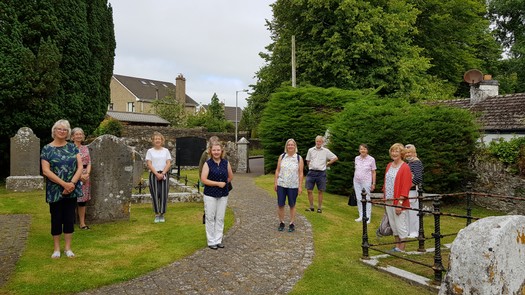
Nine MU members
from the Youghal area (including Diocesan Trustee, Veronica Deane and
her mother, Vera) joined Diocesan President, Hilary Dring, and June for a
short period of worship before
she began her 16th “21 in 21” walk. The service was held at
the beautiful Collegiate Church of St Mary in Youghal (now designated
as a national monument) and was led by the rector, Rev Canon Andrew Orr.
It included readings and lovely prayers
and Andrew spoke briefly on relevant extracts from a recent book by Rt
Rev’d Graham Usher, Bishop of Norwich, which focussed on walking with
God on the journey of life. He also presented June with a memento of
the day – a scallop shell which is often considered
a symbol
of direction along the Camino, pointing pilgrims towards Santiago.
Pilgrims also wear this symbol which further enhances the camaraderie
along this great walking trail.
With
this fresh in their minds, five walkers – Canon Andrew, Hilary, Jean
and Helen from the branch, and June set off at a brisk pace down the
hill from the church, along Ash Street
past the former residence of Sir Walter Raleigh, the old Convent and the
Quaker meeting house towards the estuary of the River Blackwater.They
joined the South Abbey and then followed the linear layout of the shore
front, past the Bandstand within Green Park,
and on to Lighthouse Road. After following the road for some distance
they proceeded to join the relatively new boardwalk beside the
magnificent beach at the Front Strand. This led them to the car park
where they stopped briefly for a well-deserved ice-cream
– it was a warm, sunny day albeit with a slight and very welcome breeze.
To
ensure that they exceeded 7km, they turned and did the walk in reverse
as far as the town centre, where they proceeded along beside the Quays
and made their way back to St Mary’s
via Church Street. There they were greeted by the other members - in
true Mothers’ Union tradition - with a most welcome cup of tea and, of
course, delicious cake!
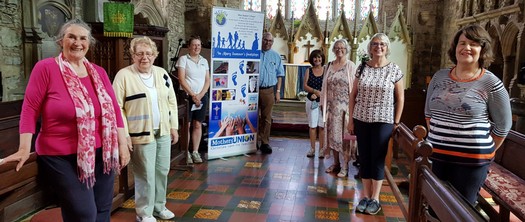
June completed her 15th walk (the second in CFO) on 12 July on territory which was familiar to her as she has friends who live in this area of south Wexford and visits there occasionally. Her friend Laurene accompanied the MU ladies on this walk. Tintern Abbey is located on the Hook Peninsula, near Saltmills, and originally was a Cistercian abbey founded by the Earl of Pembroke as the result of a vow he made when he was caught in a storm nearby. After the dissolution of the Abbey in 1562, the lands were granted to the Colclough family who lived there for the next 400 years making many improvements to the estate. The Abbey is now a ruin but, as it was passed to the state in the 1960s, parts are under restoration by the Office of Public Works. It houses several bat colonies and seven of the ten types of bat found in Ireland have been recorded there. There are four trails laid out throughout the extensive grounds, varying in length from 2.5km to 9km.
Approximately 25 ladies met at Tintern that morning and, under direction from Olive Thorpe and Olive Power, the local Branch Leader, they divided into groups depending on the length of walk they wished to take. Those present included Lesley Bayley, DP, Phyllis Grothier, former AIP, Margaret Jacob, F and C Unit Coordinator, several local branch members and some, including several Trustees, who had travelled to join the walk from other parts of the Diocese.
Seven ladies joined June in the full walk. They followed the route up to and through the woods to the east of the Abbey, across the road at the entrance to the estate and then down through the woodland path to the river. However, they were thwarted from crossing the bridge at that point and taking their intended path as maintenance work was being undertaken on the main river walk; they doubled back on a higher level path and used parts of several of the designated routes to bring arrive back at the Abbey. However, at that point they had not completed the full distance and six of group headed to the 200 year old formal Colclough Walled Garden to chat to Bea Thorpe, a former All Ireland Vice President, who had travelled to the Abbey with husband Brian when she heard that June was going to be in the area. After that respite, three stalwarts, including Margaret Jacob, wanted to ensure that June had fulfilled her full walking commitment, and the four followed the more open path besides fields to Saltmills and back to bring the total distance to 7.5km.
They then joined the other ladies for a picnic lunch and June was delighted to see and chat to Anne Barrett (former AIP) who had come along to join others for lunch. A few had also arrived from Kilkenny to continue the “craic” from the walk there the previous Thursday.
It was a lovely walk – with the occasional climb - through the fabulous grounds at Tintern, with good paths across both open and heavily wooded areas. June said that seeing the wonderful formal gardens added another dimension to the day. As ever the chat at the end was as enjoyable as the walk itself with everyone taking the opportunity to catch up with friends and colleagues they had not seen for so long, on this occasion in the shadow of the magnificent Abbey.
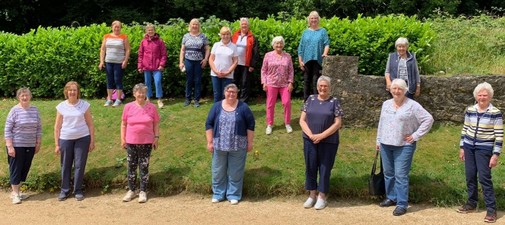
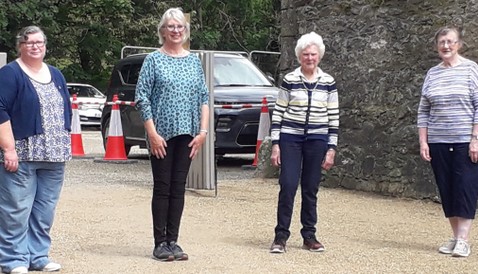
June’s fourteenth walk, her first in Meath and Kildare, began with a short formal service in the parish church of St Catherine in Tullamore – a beautiful Gothic style early 19th century church with a three story tower, sitting in an imposing location on the top of Hop Hill overlooking the Charleville estate on the edge of the town. The short service focussed on the theme of pilgrimage and was led by Rev. Fran Grasham and Rev. Isaac Delamere; June gave a short reflection and the Diocesan President, Sylvia Wheatley, read the lesson. There were very meaningful prayers, including Mary Sumner’s prayer, and two beautiful hymns – all to set the scene for a lovely walk. Around 25 people attended the service and afterwards gathered outside for lunch and light refreshments.
Those who were walking moved down to the Charleville Centre at the bottom of the hill to assemble for the 7km walk. They progressed through the outskirts of the town, along the busy main road before turning into a broad street beside the old distillery, passing the new college and down on to the banks of the Grand Canal. This was extended to Tullamore in 1798 to facilitate trade with Dublin and the paths beside it have been improved in recent years to provide an excellent facility for walkers and cyclists.
Seventeen MU members and friends began the walk and only a few were unable to stay for the full time. The walk was led by the DP, Sylvia Wheatley, and others who completed the full distance included the rector, Rev Isaac, a few Diocesan Trustees and several local branch members. They walked along the straight grass path on the right side of the Canal leading away from the town, as far as the Digby Bridge, which they crossed to return along the other side of the Canal on a bitmac path. Half way along they passed the former lockkeeper’s house at Boland’s Lock – this is now a heritage building which is open to the public.
On returning to the town at a brisk pace, June realised that this had been one of her fastest walks – probably because it was absolutely flat and the weather had been most accommodating - a dull, windless, dry day. Thirteen of the original group gathered at the Charleville Centre to say farewell and Rev Isaac prayed with them before they dispersed.
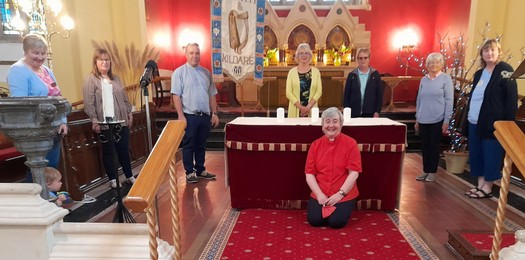
About 25 members and friends gathered at the Deanery Orchard, opposite the gates to St Canice’s Cathedral in Kilkenny, to welcome June before her 13th walk – the first she has tackled in the Diocese of Cashel, Ferns and Ossory. This space is newly remodelled from being an old neglected orchard to an outdoor meeting area with adjacent parking, all within beautiful stone walls. A great asset to the Cathedral, which sits overlooking the city of Kilkenny. There were light refreshments provided by the members of the Cathedral branch of MU before the Bishop, the Rt Rev Michael Burrows, said a few words about pilgrimage to set the walkers on their way. Among those also present were the Dean, the Very Rev’d David McDonnell, the MU Diocesan President, Lesley Bayley, the Cathedral Branch Leader, Florrie Carter, and Denise Hughes, a former Diocesan Secretary and in that a role a former work colleague of June.
The walk was led by Pat Nolan, a parishioner and historian with a fantastic knowledge of the city and its buildings. There were several suggestions at various points about June, as a Butler, returning to her “homeland” in Kilkenny but she assured everyone that she was not related to the Earls of Ormond! Sixteen walkers, including three younger friends and their mums, started down the hill from the Cathedral, turning left towards and over the new bridge, and down to walk along the banks of the River Nore. They passed the War Memorial, the Butler Gallery and St John’s Church with Pat giving historical detail at relevant points. After a short stop for ice-cream, kindly provided by Sam Harper (in his role as supportive MU spouse!), they continued along the path beside the River Nore as far as the footbridge, crossed it and came back along the other side, always with the river to their right hand side.
It was a beautiful walk with so many different varieties of trees to their left. However, when the walkers left the path to turn into the grounds of Kilkenny Castle, the vista was completely different – parkland extending to 21 hectares surrounded by ancient, huge trees many planted centuries ago. The group walked around the edge of the parkland until they reached the more formal castle gardens. Pat gave an outline of the history of the castle as they walked beside the reinstated rose gardens – in full bloom – before leaving the castle grounds, to walk along the Medieval Mile back to the Cathedral. In doing so they passed the former 13th century St Mary’s Church (now a museum), the Shee Alms House (one of the oldest in the city) and many interesting alleyways with informative names.
Eight finished the entire walk, including Bishop Michael, Margaret Jacob, the AI Fundraising and Communication Unit Coordinator, and some members of the Cathedral Branch. Everyone stayed for a picnic lunch in the Deanery Orchard and it was great for June to be able to meet members of the Branch and for them to have time to catch up with friends. The Branch presented June with a plaque depicting the 100ft high 9th century Kilkenny Round Tower, which stands beside the Cathedral.
In thanking all concerned for organising the walk, which had been approximately 7.2km in length, June said it had been one of her most informative and she was now much better informed about Kilkenny - the Cathedral, the old city, the Castle and the River Nore. Also it had been a perfect day for walking - the weather was dull but dry. After finishing lunch, June said her farewells and went off to look around the wonderful cathedral – but decided not to climb the round tower!
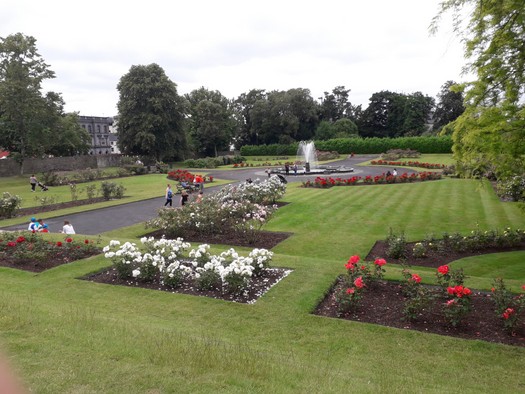
The Rose Gardens in the grounds of
Kilkenny Castle
June’s twelfth walk on 29th June marked the completion of one third of the planned 36 walks. This second walk in the Diocese of Kilmore, Elphin and Ardagh began with a short act of worship for the twenty or so MU members who had gathered at St John’s parish in the centre of Longford. This was held in glorious sunshine and was led by Ann Howard, a Diocesan Trustee, and by the branch leader, Diane Stewart. There were prayers, and bible readings and even hymns amplified across the graveyard from Ann’s phone. Fittingly one of these was “Walk, walk in the light”!! June was presented with a lovely bag of Longford “goodies” and she spoke for a few minutes about MIM and this year’s efforts to rebuild the Fund all focussed around “21 in 21”.
Just after 11am about 15 MU members started the walk which involved several laps around The Mall. This park is situated close to the centre of the town of Longford and can be easily assessed from St John’s Church. The Mall Walking Trail is a looped 2.6km of gravel paths in this beautifully landscaped park on the banks of the river Camlin, with many wonderful varieties of trees and beautiful flower gardens. It is home to Longford’s sports and leisure complex and has also many sets of outdoor exercising equipment and a children’s activity play area. The park is also known as the Albert Reynolds Peace Park after the former Irish Taoiseach who originally served as a TD for Longford-Westmeath from 1977.
On their circuits the walkers discovered in the centre of the park a wildlife sanctuary and an interesting stone circle sculpture, known as "Timelessness". It was created by a local artist between 1999 and 2000 to celebrate the arrival of the new millennium. Three of the stones are marked, while the fourth has been left for someone to sculpt at the dawn of the next millennium.
June walked around the park with various MU members including Ann who was determined to regain her fitness after a recent knee replacement, Hazel Speares, the Diocesan President, and Vida McAuley, a Diocesan VP who had recently walked 21kms in a day in Deerpark Forest at Virginia to raise funds for MIM! Various branch and diocesan members joined and left during the morning as they had time and energy. It was the perfect morning for walking - sunshine and a breeze - on flat surfaces or grass if preferred, as in one area some of the tar on the path began to melt in the heat – a very unusual occurrence on June’s “21 in 21” walks!
Seven members completed three and a half laps bringing the distance covered to over 7kms. They then adjourned back to meet the others at the church for refreshments and a rest! June chatted there with several members she remembered from her early days in MU, including Canon Margaret Sides whom she hadn’t seen for many years, and also a number of newer members. All were so enthusiast about MU in and around Longford. Some present even began to plan June’s third walk in KEA!

Before she began her 11th walk, about forty members from KEA joined with June, Bishop Ferran Glenfield, the Diocesan Chaplin, Rev Richard Waller and the local rector, Rev Simon Donohoe, for a short time of prayer at TomRegan Church, Ballyconnell . June also said a few words about her “21 in 21” challenge and about the MIM Fund.
A group of 30 set off down the hill from the church into Ballyconnell village and, at the end of the main road through the village, turned right to join the path beside the Woodford Canal, part of the Shannon-Erne Waterway which was re-opened in 1993. The walk was led by Phyllis Cassidy (who is a member of the Swanlinbar/Kilallon MU branch based in the church at Ballyconnell) and she set a brisk pace for the walk. Others who did the full distance included the three clergy as well as Diocesan President, Hazel Speares, Barbara Smith, Diocesan Secretary and several other Diocesan Trustees. About 20 completed the full 7kms while the others opted for a slightly shorter walk.
It was a glorious afternoon - sunny with a light breeze - and the walkers crossed the Woodford Canal bridge before proceeding along the banks of the canal with both open aspects and welcome shady areas with wild flowers growing beside the path. There were very few others on the path – a really peaceful haven. June was especially taken with the absolutely magnificent old trees of many varied species.
After about 5½ Kms the walkers left the path and made their way up to the ring road surrounding the village, and then followed the main road (N87) through the village, crossed the bridge over the River Woodford and up the hill to the parish hall which is located across the road from church. There the Branch Leader, Lorna Graham, had organised refreshments and everyone joined together in a time of fellowship and rest before this most pleasant afternoon ended with everyone saying the Grace.
